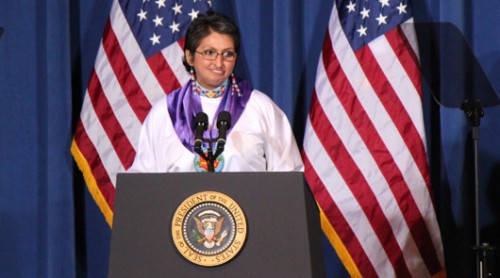Department of Justice Tribal Access Program (TAP) Will Improve the Exchange of Critical Data
Department of the Interior Companion Program to Provide Name-Based Emergency Background Checks for Child Placement
Source: United States Department of Justice
The Department of Justice is launching an initial phase of the Tribal Access Program for National Crime Information (TAP) to provide federally-recognized tribes access to national crime information databases for both civil and criminal purposes. TAP will allow tribes to more effectively serve and protect their communities by ensuring the exchange of critical data.
This initial phase of TAP was announced today in a meeting with tribes held during the 2015 Department of Justice/FBI Criminal Justice Information Services (CJIS) Division Tribal Conference in Tulsa, Oklahoma.
“Federal criminal databases hold critical information that can solve crimes, and keep police officers and communities safe,” said Deputy Attorney General Sally Quillian Yates. “The Tribal Access Program is a step forward to providing tribes the access they need to protect their communities, keep guns from falling into the wrong hands, assist victims and prevent domestic and sexual violence. Empowering tribal law enforcement with information strengthens public safety and is a key element in our ongoing strategy to build safe and healthy communities in Indian country. ”
“The FBI is pleased to participate in this initiative,” said Executive Assistant Director Amy Hess of the FBI’s Science and Technology Branch. “This will be a positive step for the tribal agencies to receive valuable criminal information and also for those same tribal agencies to submit criminal information at the national level. Through this partnership, information becomes richer and communities can become safer.”
TAP will support tribes in analyzing their needs for national crime information and help provide appropriate solutions, including a-state-of-the-art biometric/biographic computer workstation with capabilities to process finger and palm prints, take mugshots and submit records to national databases, as well as the ability to access CJIS systems for criminal and civil purposes through the Department of Justice. TAP will also provide specialized training and assistance for participating tribes.
While in the Tribal Law and Order Act of 2010 Congress required the Attorney General to ensure that tribal officials that meet applicable requirements be permitted access to national crime information databases, the ability of tribes to fully participate in national criminal justice information sharing via state networks has been dependent upon various regulations, statutes and policies of the states in which a tribe’s land is located. Therefore, improving access for tribal law enforcement to federal criminal information databases has been a departmental focus for several years. In 2010, the department instituted two pilot projects, one biometric and one biographic, to improve informational access for tribes. The biographic pilot continues to serve more than 20 tribal law enforcement agencies.
Departments of Justice and Interior Working Group
In 2014, the Departments of Justice and the Interior (DOI) formed a working group to assess the impact of the pilots and identify long-term sustainable solutions that address both criminal and civil needs of tribes. The outcome of this collaboration was the TAP, as well as an additional program announced today by the DOI’s Bureau of Indian Affairs (BIA) that provides tribes with national crime information prior to making child placement decisions in emergency circumstances. Under the BIA program, social service agencies of federally recognized tribes will be able to view criminal history information accessed through BIA’s Office of Justice Services who will conduct name-based checks in situations where parents are unable to care for their children.
“Giving tribal government programs access to national crime databases through DOJ’s Tribal Access Program for National Crime Information is a tremendous step forward towards increasing public safety in Indian Country,” said Assistant Secretary Kevin K. Washburn for Indian Affairs at the Department of the Interior. “The Bureau of Indian Affairs Office of Justice Services’ Purpose Code X program provides a much-needed tool for tribal social service agencies when they must find safe homes to place children during temporary emergency situations.”
In the initial phase of the TAP program, the biometric/biographic workstations will be deployed to up to 10 federally-recognized tribes who will provide user feedback. This phase will focus on assisting tribes that have law enforcement agencies, while in the future the department will seek to address needs of the remaining tribes and find a long-term solution. The department will continue to work with Congress for additional funding to more broadly deploy the program.
The Department of Justice’s Chief Information Officer manages TAP.
“It is our hope that TAP can minimize the national crime information gap and drive a deeper and more meaningful collaboration between the federal, state, local and tribal criminal justice communities,” said Chief Information Officer Joseph F. Klimavicz for the department.
For more information on TAP, visit www.justice.gov/tribal/tribal-access-program-tap.
For more information about the Justice Department’s work on tribal justice and public safety issues, visit: www.justice.gov/tribal.
For more information about the Department of the Interior Bureau of Indian Affairs, visit www.indianaffairs.gov/





